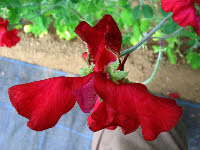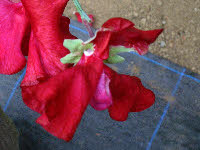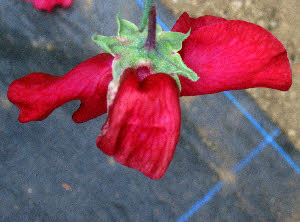home page




The picture on the left and the centre one above show what went wrong. The genetic instructions for making sepal and standard petal were damaged, maybe by impact or radiation, at an early stage of flower differentiation,
The centre part of the sixth sepal that should come to a point has become integrated with the standard petal, so that the sepal has acquired colour, length and width that belong to the standard.
It is very uncommon for the sepals to be involved in distortion. That seems natural, since the calyx is completely developed, except in its size, before the petals inside it become distinguishable.
The natural type of the species has five sepals, ten anthers, and one standard petal. Calyces composed of more than five sepals are often associated with extra petals and extra anthers, and those generally result in malformed flowers.
The commonest cause of gross distortion is failure of differentiation between filament
and petals -